So often associated with the good life, oysters have a long and winding path to travel before they reach the crushed ice platter. For one Australian producer, the journey itself is making a difference.
By Daniela Frangos
Of all the sea’s bounty, oysters command a special place in our folklore and dining rituals. A natural partner of Champagne, they have long been the stuff of celebration and decadence. And now, thanks to the careful stewardship of a new generation of farmers, they comprise one of the most valuable aquaculture industries in Australia.
In 2018-19, the gross value production for the Australian oyster industry totalled $106m. But long before they make it to fishmongers and restaurant kitchens, oysters have a far greater role to play—one that profoundly impacts the local ecosystem and renders their economic value an enormous environmental opportunity.
“Bivalves and seaweed are the only [aquaculture species] that remove nitrogen from the water. Most other farmed or cultivated species produce nitrogen,” says Dr Rachael Marshall, general manager of Accounting for Nature, an Australian organisation that provides an environmental accounting framework to inform better investment, policy and management decisions in natural capital.
These multifaceted molluscs sequester carbon and maintain water quality by filtering seawater (a single oyster can filter 100 litres of water a day), while oyster reefs provide habitat and food sources for a range of marine organisms. Oysters also serve as natural breakwaters, reducing the impacts of erosion.
“They’re so sensitive to environmental changes,” Marshall says. “When they’re healthy, the waterways are healthy; when the waterways are healthy, they’re healthy.”
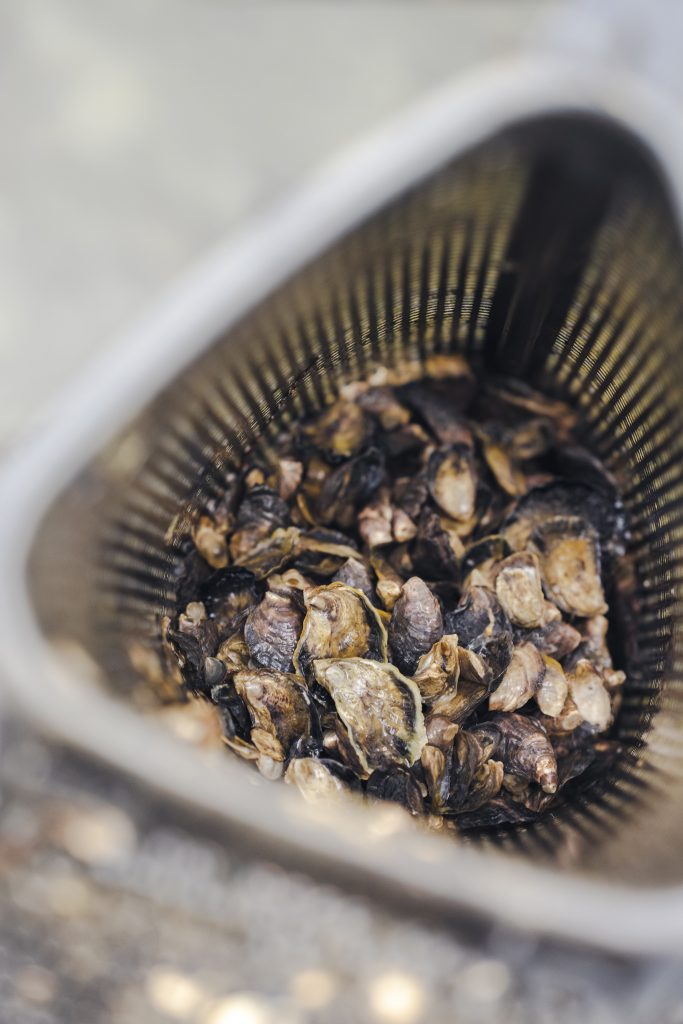
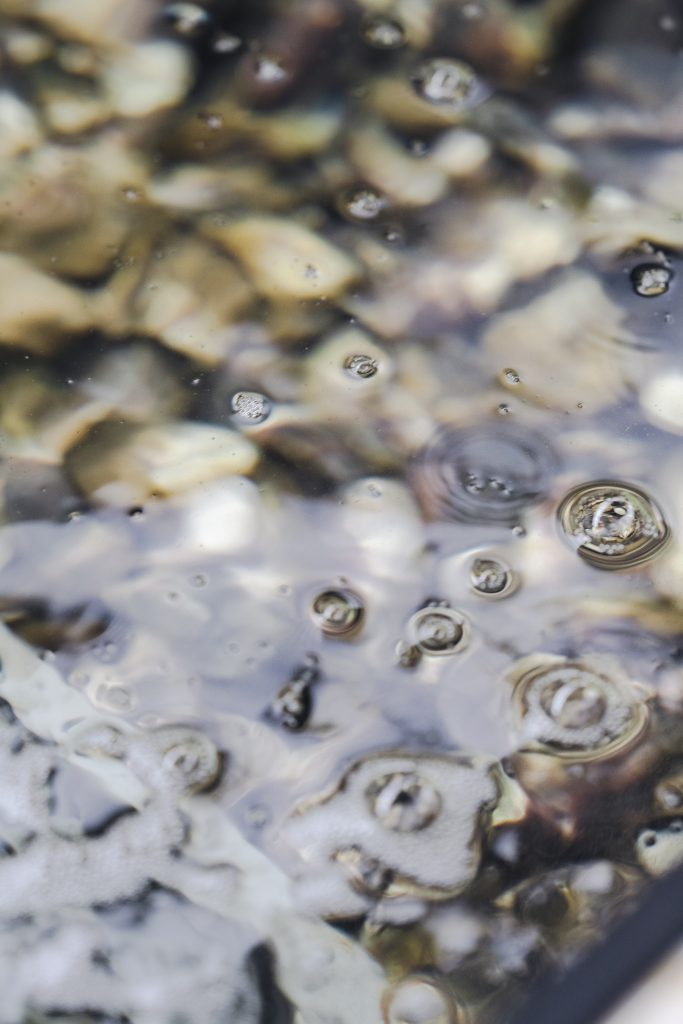
Amid the growing talk of regenerative farming, the many benefits of oyster farming are part of a story rarely told. “Oyster farming in itself is almost a regenerative farming industry, Marshall explains. “Especially at the capacity we farm them in Australia—we’re not in any way risking over-farming,” she says.
“[The industry] has so many environmental services just built into the nature of the farming. Oyster leases restrict other fishermen coming in and overfishing those areas and provide infrastructure for other species, like seagrass, to grow. But one of the biggest challenges oyster farmers have had is communicating that positive story to the public.”
“The majority of people don’t know how oysters are grown,” says oyster farmer Shane Buckley of Wapengo Rocks, a certified organic oyster farm on Wapengo Lake on the far south coast of New South Wales. Buckley, who supplies restaurants along the east coast including Saint Peter and Cafe Paci in Sydney, and MoVida and Hazel in Melbourne, farms the Sydney rock variety, which is native to the area, having grown there for thousands of years and been farmed since the late-1880s.
The clean waters that flow into Wapengo Lake are already filtered by the surrounding national parks, state forests and salt marshes. But Buckley has set out to improve the water quality on his leases even further by removing all polluting products and infrastructure.
That means no more treated pine or tar-coated sticks on the farm (these materials have traditionally been used in the oyster industry because of their durability and low cost), replacing them with recycled or recyclable materials. He’s also reduced some of the lease’s other traditional set-ups in a bid to improve estuarine habitat.
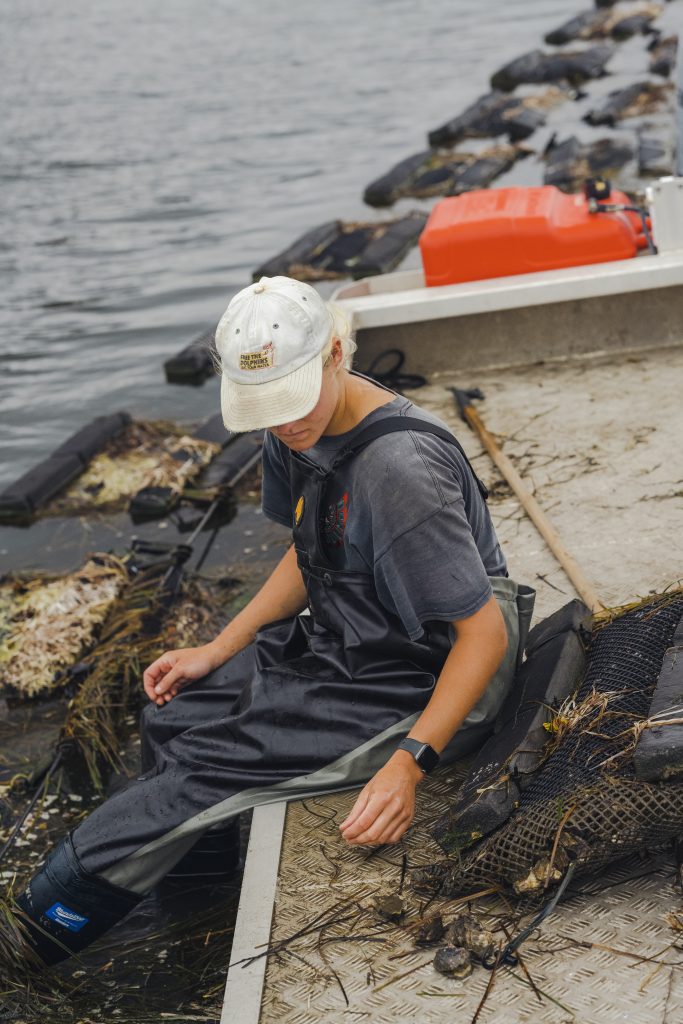
“We’ve removed the majority of the fixed infrastructure that used to shade the lake bed,” Buckley explains, noting the exception of the catching slats, which are only used six months of the year. “That shading stopped marine growth and weeds from establishing, so we put in floating infrastructure that moves with the tide and the wind, which has let light back to the lakebed and all the old weed beds have re-established.” He says the benefits haven’t stopped there; “The infrastructure itself creates habitat, food and shelter for young fish, crustaceans and all sorts of marine animals, and provides shelter from predation.”
According to Buckley, New South Wales’ far south coast is the “golden triangle” for growing Sydney rock oysters. “They grow slower and take longer to mature so they get deeper and fatter—it’s the perfect environment for them down here,” he explains. “The flavour profile changes throughout the year, which is influenced by the amount of food available to them, and the water temperature. They get leaner during the winter and they’re really fat and creamy [in summer]—like a soft poached egg texture—just huge amounts of cream and sugar, and you get a real hit of seaweed umami through the warmer months.”
Melbourne chef Oliver Edwards (ex-Hazel, Cumulus Inc) is a self-described oyster fanatic and dedicated sustainable seafood advocate. Having grown up in Tathra on New South Wales’ Sapphire Coast, about a half-hour drive from Wapengo Lake, Edwards is a passionate long-time fan of Wapengo Rock oysters and has shucked them in kitchens for years.
“Oysters are the complete package,” he says. “A great oyster needs no adornment and by itself has the perfect balance of briny, creamy, mineral and vegetal flavours. A little acid in the form of lemon or vinegar (such as in a mignonette) can lift an oyster, but the best oysters are great all by themselves.”
Edwards adds that, while often overlooked, an oyster’s origin is just as pertinent as a wine’s terroir. “I love that they taste of a moment—they reflect the time and place they were grown and harvested,” he explains. “Oysters from different estuaries or bays will taste completely different depending on the balance of fresh and salt water, the particular algae and minerals in the water, the temperature, their age, and other factors. An oyster is a snapshot of that waterway at that time.”
He continues: “I use Shane’s oysters because they’re delicious, first and foremost. But I also know how pristine the waters are in Wapengo Lake. Shane’s commitment to sustainability is also important to me. His use of a floating system rather than tarred posts means less impact on the lake bottom, less overshadowing, and more chance for native seagrasses to thrive.”
Frank Camorra, owner-chef of Melbourne’s MoVida group of restaurants shares similar thinking; “The fact that Shane’s oysters have been well cared for shines through on the plate.” High quality ingredients can certainly make life easier for a busy chef. “No garnish [needed], I always eat them natural,” he adds.
Oyster reefs once blanketed thousands of kilometres of Australian coastline, until they were dredged to near extinction after European colonisation. A nationwide restoration program is seeking to bring them back, with sites now in Queensland, New South Wales, Victoria, South Australia and Western Australia. There is also work being done to protect these reefs into the future as oceans become warmer and more acidic. Scientists in south-east Queensland recently made a game-changing breakthrough, successfully breeding blacklip rock oysters, a fast-growing, disease-resistant, heat-tolerant species they hope will future-proof that state’s oyster farming industry against the impacts of climate change. In New South Wales, Wiradjuri scientist Dr Laura Parker is leading a project breeding climate change-resilient Sydney rock oysters while restoring degraded oyster habitats that hold enormous importance to First Nations people.
Buckley says it’s difficult to quantify the effects of climate change on his own farm. “I’ve only been in the game for 16 years. The data set to really understand anything like that needs to be looked at over a very long period of time.” But he says the prevalence—and impact—of recent flooding and fires cannot be ignored.
The most recent summer was the first summer season since 2017 that Buckley’s farm had been open to harvest.
“In 2018, we were closed because we had a rainfall event, which was unprecedented back then because we were in the midst of a drought,” he recalls. “Then, in 2019 we had bushfires that lasted for weeks and weeks. For months we were on constant alert. We had a lot of ash and fire debris in the water, which was no good for the oysters.”
“Every year since, until just recently we’ve had continual floods. I think we’ve had 14 floods in the past three years. The last financial year we had 15 closures to harvest because of rainfall events, so that’s a bit of an indication of how hard the industry’s been hit.”
Last year’s devastating QX disease outbreak in Port Stephens (an area which previously produced about 16 per cent of New South Wales’ oysters) also had a huge effect on other farms, which would normally buy spat (oyster larvae) from its hatcheries and nurseries to boost their own populations.
Organisations like Accounting for Nature can help producers such as Buckley calculate, in cold, hard data, the economic value of protecting these waterways, providing farmers with a scientifically robust way of measuring, verifying and certifying changes in the condition of environmental assets—be they native vegetation and fauna, soils, waterways, or other natural capital.
Dr Rachael Marshall says this framework is critical in guiding investment in sustainable land and sea management, enabling natural resource managers, policymakers and investors to link the condition of environmental assets with economic decision-making.
“We currently have 6 million hectares in Australia under environmental account and we’re expecting to double that by the end of 2023,” Marshall explains. “It’s so far been predominantly targeted at the land sector because that’s where the demand has been … but if there was the need to track the condition of the seabed or the area in which the oysters are being leased, that’s how the oyster industry could use this framework. They could measure water quality, seagrass; they could measure turtle numbers,” she continues. “I know there are farms at Moreton Bay where they’re seeing a lot of turtles return to the area, and seagrass and molluscs and juvenile fish; the whole oyster lease is alive.”
It’s a scene rarely pictured when you’re sitting at your favourite bar or restaurant, about to begin the evening’s festivities with a plate of freshly shucked oysters. But it does lend credence to the idea of oysters being the go-to pairing for the little celebrations of life, something with which Camorra—whose three MoVida restaurants collectively serve around 100 dozen oysters each week—agrees wholeheartedly. “An oyster and a glass of manzanilla sherry is a match made in heaven,” he says. “And if you’re having a special occasion, it’s like: ‘Let’s start with some oysters, let’s celebrate eating out and just celebrate life in general’.”
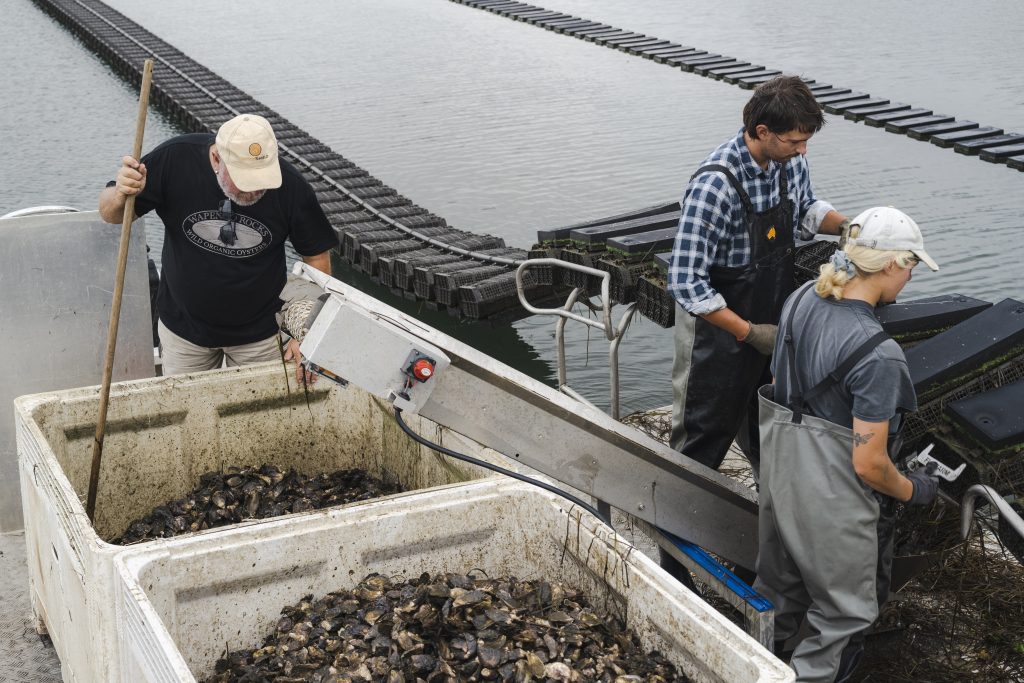
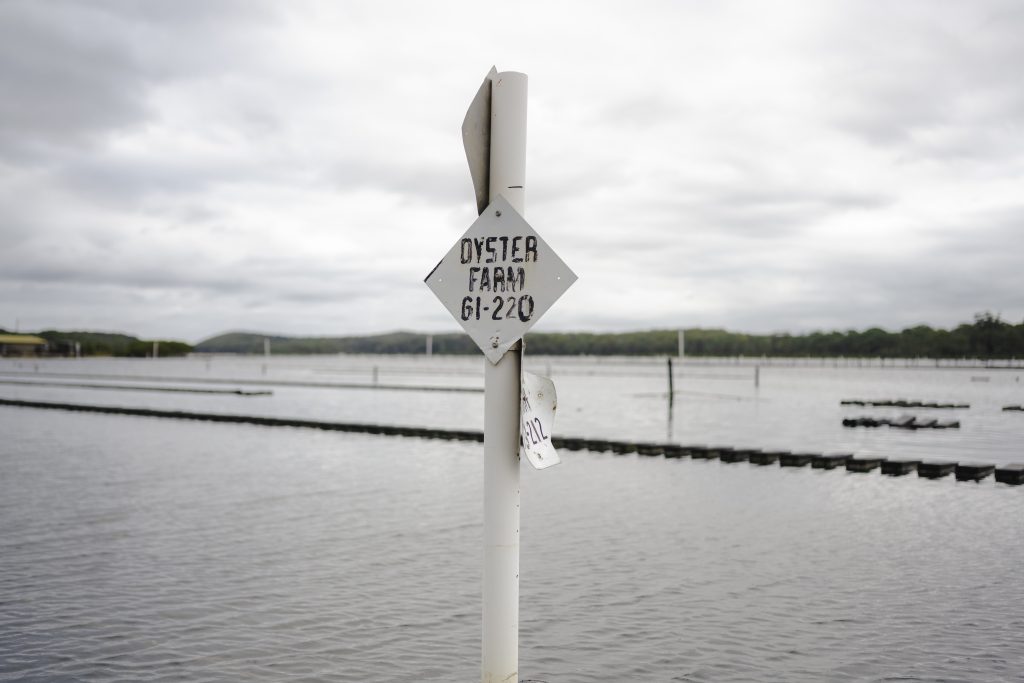
SERVE WITH A GLASS OF…
Proving that there’s much to explore beyond the classic Champagne match, Melbourne wine importer Campbell Burton serves up some unlikely inspiration for your next oyster pairing.
He says: “Rather than isolating a single wine variety, be guided by style—ideally opting for drinks that mirror the oyster’s structure and flavour profile. Soft, textural wines grown in coastal areas get the tick, particularly those displaying minerality and iodine elements, such as the zesty Carricola Blanco by Celler Tomàs Torres and the Domaine de Kalathas “Sainte Obéissance” from the Greek Cyclades.
An iodine-rich Spanish sherry like the Callejuelua Manzanilla from Marco de Jerez also works well while brut cider such as the Fuente Guijarro Sidra Metodo Clasico from Spain’s Sierra Nevada and the salty, malty Tasmanian-brewed Two Metre Tall Oyster Stout deliver similarly delightful results.”
